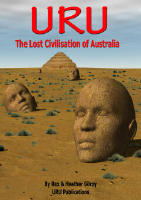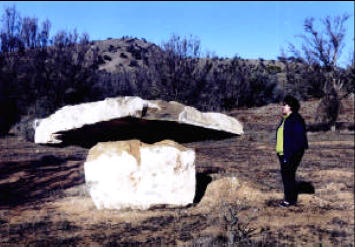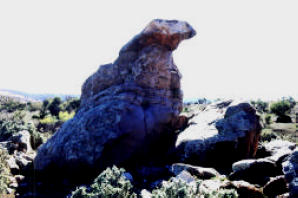Altars Of The Phallic Gods [continued]
In the wake of their development of an advanced astronomical science; a people thirsting for knowledge and the meaning of life, who created a mighty religious philosophy second to none; and which they would spread across the earth in the shadow of their megaliths. In Chapter Two I have already presented the basic creation mythology of the Uru, which began with Ay-i or Ki, the pre-existent “life force”. The word Ay-i, a variant of ‘Aryan’ as was ‘Uru’, linked this people to their supreme being as joint creators of their world.
Indeed, it appears they came to regard themselves and their supreme being Ay-i as one-and-the-same, the God Himself, and the land of Uru a living being to which prayers and sacrifices should also be offered up upon the altars.
As previously stated, Ay-i created the universe within a great cosmic egg, inside which he brought all life into existence, beginning in the land of Uru. Here He created an earthly paradise. To tend His paradise and all the creatures therein, He breathed life into the soil to create Nif, the great virgin Earth-Mother Goddess.
Yet His world was in darkness. To light it Ay-i mated with Nif to produce two light-giving children: Nim, the Sun-God, to radiate life-giving light and warmth by day; and Ara, the Moon-Goddess, to bring illumination at night.
Nif bore her children in a cave in the east, from where Nim rose each morning to cross the sky to the west, from where he travelled to the Underworld to sleep [or even die, as some believed], then rise again in the east.
Ara rose from her sleep in the birth cave with the approach of darkness caused by Nim’s departure in the west, and followed him across the sky to pursue him through the Underworld.
Ara was not as fast as Nim and only caught up with him on occasions by day, as recorded in one Uruan astronomical inscription found near Katoomba.
To watch over Nim and Ara Ay-i created the eagle I-na as protector of his children. This I-na, the Eagle of the Sun, alternatively carried Nim in his beak across the sky from the Earth-Mother’s cave each morning, and through the Underworld to deposit him back in his mother’s cave, while he then, as Eagle of the Moon, conducted the Moon-Goddess through the Underworld to Nif’s cave in the same manner.
Then he would repeat the process over again. While I-na had permanent employment, his job must have been boring at times [his roles are depicted in the Katoomba inscriptions]! And Ara was left to find her own way across the sky at night.
As mentioned before, when not depicted in rock art as a disc, Nim became a serpent, the symbol of his life-giving rays. The serpent was the guardian of knowledge and also a phallic symbol; his name, both as a minor deity and species was Ra-na [‘na’ meaning ‘of’ in Uruan language, and ‘Ra’ would later become the Egyptian name for the Sun-God].
The following beliefs of the Uruans concerning what lay beyond death has been gleaned from rock inscriptions over many years.
The Underworld land was created by Ay-i as the home of Ashar, whom he appointed as god of death and darkness and judge of the dead. Here was his awesome home and temple. Shut off from his abode was a separate “land of the wicked”, a dark and terrifying place reserved for the departed souls of evildoers.
At death the soul was judged by Ashar, who stood before the entrance of the Afterlife. If the soul had led a wicked life it was immediately dispatched to the Underworld “land of the wicked”; and if it had led a good life, it was sent to live in Ay-i’s ‘heaven’, ruled over by Nim, and which Uruans believed was on this earth on a parallel plane of existence. Here souls continued to live on as before in renewed bodies.
For many years the author had puzzled over the mysterious lack of human remains of this people. It is now certain that the Uru cremated their dead from earliest times, though eventually the remains of their rulers were placed in crude megalithic tombs, which became more elaborate from around several thousand years ago, as demonstrated by the Moonbi Range phallic-shaped granite tomb of King Namou [see previous chapter].
Nim gave fire to Earth in the form of the Fire-God, Aru, whom Ay-i made subservient to Nim. ‘Aru’, another variant of ‘Aryan’, came to symbolise the all-consuming power of the Aryan race in its spread across the ancient world. In the course of Aru Fire-God rites great beacons were lit at night upon high places across the Australian landscape.
Fertility celebrations of one kind or another centred around just about every major deity of the Uru, chiefly Ay-i, Nim and Nif, but also the Phallic-God, Wa-na-ma, God of Love and Sex. Certain rock art found nearby standing stones describe orgiastic rites having been performed in his name, often upon a grand scale!
Ay-i must have seen the need for an overseer of his earthly deities. Observing the kangaroo and wallaby, or Ga, as these animals were known to the Uruans, and recalling that he had given the females a body pouch in which to keep their young for protection, Ay-i named them Ga-na, “Protector of the Gods”.

 Western Alignment
Western Alignment 


 Ga-na
Ga-na  Ancient Pathway
Ancient Pathway  Sandstone Platform
Sandstone Platform 
